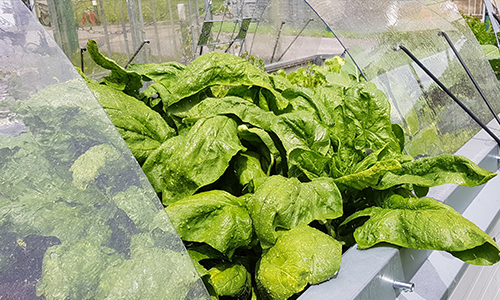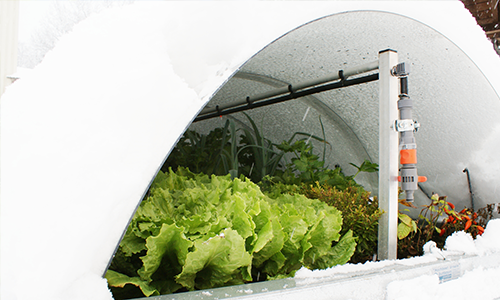mixed culture in raised beds
The ultimate goal of every passionate gardener is to achieve a high-quality harvest . But what do you have to do to achieve a high yield in your own garden?
One of the keys to success lies in mixed culture , especially in raised beds . These are becoming increasingly popular due to their space efficiency and ease of management . However, not all plants get along with each other, while others harmonize particularly well. Some vegetable and herb combinations can even promote each other's growth by improving the soil's nutrient supply, repelling pests or simply optimizing the use of space.
The secret of successful cultivation in raised beds is Research and planning . If you want to create your raised bed , you should find out which varieties are particularly suitable for mixed cultivation. Hochbeet.com is there to help you with the best tips for a high-quality and long-lasting harvest.
Mixed cropping in raised beds is an excellent strategy to maximize productivity while ensuring soil sustainability . When multiple crops are planted together, a synergy is created that brings numerous benefits. But what exactly are these benefits? And why are raised beds the ideal environment for mixed cropping? The experts at Hochbeet will tell you more about raised bed cultivation here.
The Principles of Mixed Culture
Before looking at the benefits, it is important to understand what mixed culture means. It is a System in which different plants are grown together in the same space. This approach mimics, to some extent, the diversity of natural ecosystems and results in a more balanced and productive garden.
Advantages of mixed culture in raised beds
– Nutrient efficiency: As mentioned above, different plants require different nutrients in the soil and replenish them. This balance ensures that the soil is not lacking in a particular nutrient.
– Pest control : Some plants can repel pests that attack other plants. For example, the smell of certain herbs can keep harmful insects away.
– Space optimization: In a raised bed, the proximity of plants can help suppress weeds, making the most of every square inch.
– Promoting biodiversity : Mixed culture increases biodiversity in your raised bed and promotes the presence of natural pest controllers and beneficial insects for pollination.
– Soil health: The roots of different plants interact in ways that can improve the structure and health of the soil, making it more fertile and permeable.
The mixed culture and the close connection to sustainability
The health and productivity of a raised bed are directly linked to the well-being of the soil . Central to this well-being is nutrient cycling, an essential process for maintaining balance in the raised bed. Plants absorb the nutrients they need from the soil through their roots. These nutrients promote the growth of the plant and enable it to produce leaves, flowers and fruit.
When we consume grown vegetables, we benefit directly from these nutrients as what was once in the soil is converted into energy for our bodies.
But nature's uniqueness also lies in its renewal cycle . Not all nutrients are absorbed by plants or consumed by us. Some of what the plants extract returns to the soil, for example in the form of fallen leaves or plant remains.
This is where compost comes in. Recycling organic waste through composting allows nutrients to be returned to the soil . Not only does this keep the soil fertile and lush, it also helps prevent waste and creates a truly sustainable gardening system.
Which plants go best together?
Apart from knowing which plants should not grow together, it is important to know the combinations that are mutually beneficial. Here are some combinations that every garden lover should consider:
– Beans and corn: Beans grow on the corn and use it as a natural support, while in turn they fix nitrogen in the soil, which is essential for the growth of the corn.
– Tomatoes and basil : They go perfectly together not only on the plate, but also in the garden. Basil repels some pests on tomatoes and can even improve their taste.
– Lettuce and radishes : They grow well together because they have different root depths and do not compete for soil resources.
– Carrots and onions : Onions deter the carrot fly, a common pest of carrots, while the smell of carrots can deter flies from onions.
– Pumpkin, corn and beans: This combination of three is an ancient Mayan method. These plants support each other in their growth. The corn supports the beans, the beans enrich the soil with nitrogen, and the pumpkin covers the soil and keeps it cool and moist.
Opting for these combinations in raised beds not only maximizes productivity but also helps reduce pesticide use as the plants protect each other. This sustainable and ecological method is ideal for anyone looking for an environmentally friendly approach to gardening.
Practical tips for your mixed culture
The key to a successful community garden lies in planning and considering a few basic principles:
– Garden planning: Before planting, learn about the different plant species to understand their needs and compatibility.
– Planting distances : Each plant needs its own space to grow optimally. Appropriate spacing prevents overcrowding and promotes healthy growth.
– Crop rotation : Changing the location of plants every year prevents the accumulation of pests and keeps the soil fertile.
Protection and care for the perfect mixed culture in the raised bed
However, for mixed culture in the raised bed to be successful, you must also pay attention to many other factors that can jeopardize the end result. There are a few basic steps that must be followed to care for and protect the raised bed :
– Protective nets : Using protective nets on raised beds can prevent damage from birds, insects or other animals. In addition to protecting against unwanted creatures, these nets can also provide some protection from the elements such as hail.
– Irrigation : A well-designed irrigation system is essential. Plants have different water needs, and consistent irrigation can ensure that all plants receive the amount of water they need.
– Preparing for bad weather : Watch the weather forecast and prepare to protect your raised bed in case of bad weather. This may include using covers or tarps, or even relocating plants if possible.
The secret behind a successful mixed culture lies in the planning, research and the ability to adapt to the needs of the plants and the climatic conditions. With enough attention and care, you will find the perfect mixed culture for your raised bed.
Which vegetables go together?
Find out which vegetables grow together in raised bed grow – and which combinations could cause problems!



